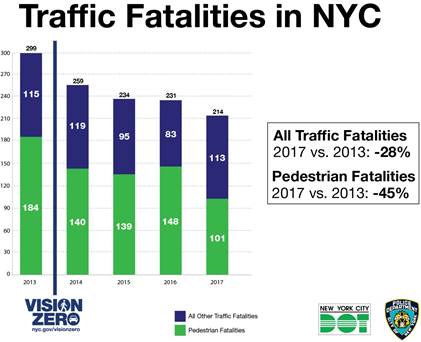NYC traffic fatalities fell for the fourth year running in 2017, with an especially large drop in pedestrian deaths, Mayor de Blasio announced today.
While the city's Vision Zero initiatives aren't on pace to hit the goal of eliminating traffic deaths by 2024, New York has managed to buck national trends and make significant safety gains. The de Blasio administration has redesigned streets, recalibrated traffic signals, and reduced lethal vehicle speeds with a lower citywide speed limit and expanded use of automated enforcement -- and it is clearly making a difference.
"The idea behind Vision Zero was that there were so many crashes that happened that did not have to happen, and that we could change things so that lives would be saved," the mayor said at a press conference in Queens this morning. "The bottom line is now four years of evidence proving that Vision Zero works."
The gains under de Blasio follow a long-term trend that began in the 1990s. While the mayor was too eager to claim all the credit for traffic safety policies that predate his administration, New York has distinguished itself from other American cities under his stewardship.
Pedestrian fatalities are rising nationally, but in NYC they have fallen 45 percent since 2013. Instead of getting swept up in the mistaken belief that ticketing pedestrians will make streets safer, for the most part New York has followed through on a core strategy of limiting motor vehicle speeds and increasing driver attentiveness.
The de Blasio administration -- NYPD in particular -- is still prone to terrible misfires like its e-bike enforcement campaign, but DOT's street reengineering continues to chip away at the most severe crashes.
In addition to high-profile projects like protected bike lanes, which tend to improve safety for all modes of travel, DOT is getting a lot of mileage out of adjustments to traffic signals.
In 2017, DOT installed 832 leading pedestrian intervals, which give pedestrians a head start to cross at intersections ahead of turning motorists. That brought the citywide number of LPIs to 2,334, a seven-fold increase since 2013. DOT also retimed traffic signals to discourage speeding and bring drivers in line with the city's default 25 mph speed limit.
There's still a lot of work to be done. 2017 was the deadliest year for cycling in several years, with 23 bicyclist fatalities, not including the victims of October's greenway terror attack. Motor vehicle occupant fatalities also increased, from 46 to 57.
As he begins his second term, de Blasio pledged to take Vision Zero "farther." He called on the state legislature to expand the city's school speed camera program.
"We need help in Albany, and I know the family members, who've done so much work up there, the family members who lost their loved ones to traffic crashes, they will be up there in force in 2018 to get further progress in Albany," he said.
Expanding the city's speed camera program, which is still tightly constrained, would save lives, but there are other policy options that de Blasio will have to embrace to achieve his Vision Zero target. Congestion pricing, for instance, led to major reductions in severe crashes in London, but the mayor remains stubbornly opposed to it.
To keep making progress, said Transportation Alternatives Executive Director Paul Steely White, City Hall needs to get serious about cutting down on car trips.
White said the drop in pedestrian deaths "leaps out as a huge achievement" that needs to be accelerated and expanded. "For them to make good on Vision Zero in a substantial way, they can’t avoid the too-many-cars problem," he said. "The lion's share of street space is still going to motor vehicles."
The increase in bicyclist deaths is especially concerning. "We’ve seen bike deaths rise for three years, and it’s clearly a gap right now in the way Vision Zero is being implemented," he said.
In many parts of the city, opposition has led the city to stall or scale back safety redesigns. The sustained reduction in fatalities should bolster the political case for moving forward with bolder street designs more rapidly.
At today's press conference, newly-elected City Council Member Bob Holden, who previously opposed protected bike lanes, safety improvements on Woodhaven Boulevard, and Vision Zero policies in general as head of the Juniper Park Civic Association, said he's had a change of heart.
"I was one of those 'Doubting Thomases' on the civic level," Holden said. "You can't argue with saving lives. You can never argue that that's the paramount here."
"I was wrong, I want to admit that," he said.







